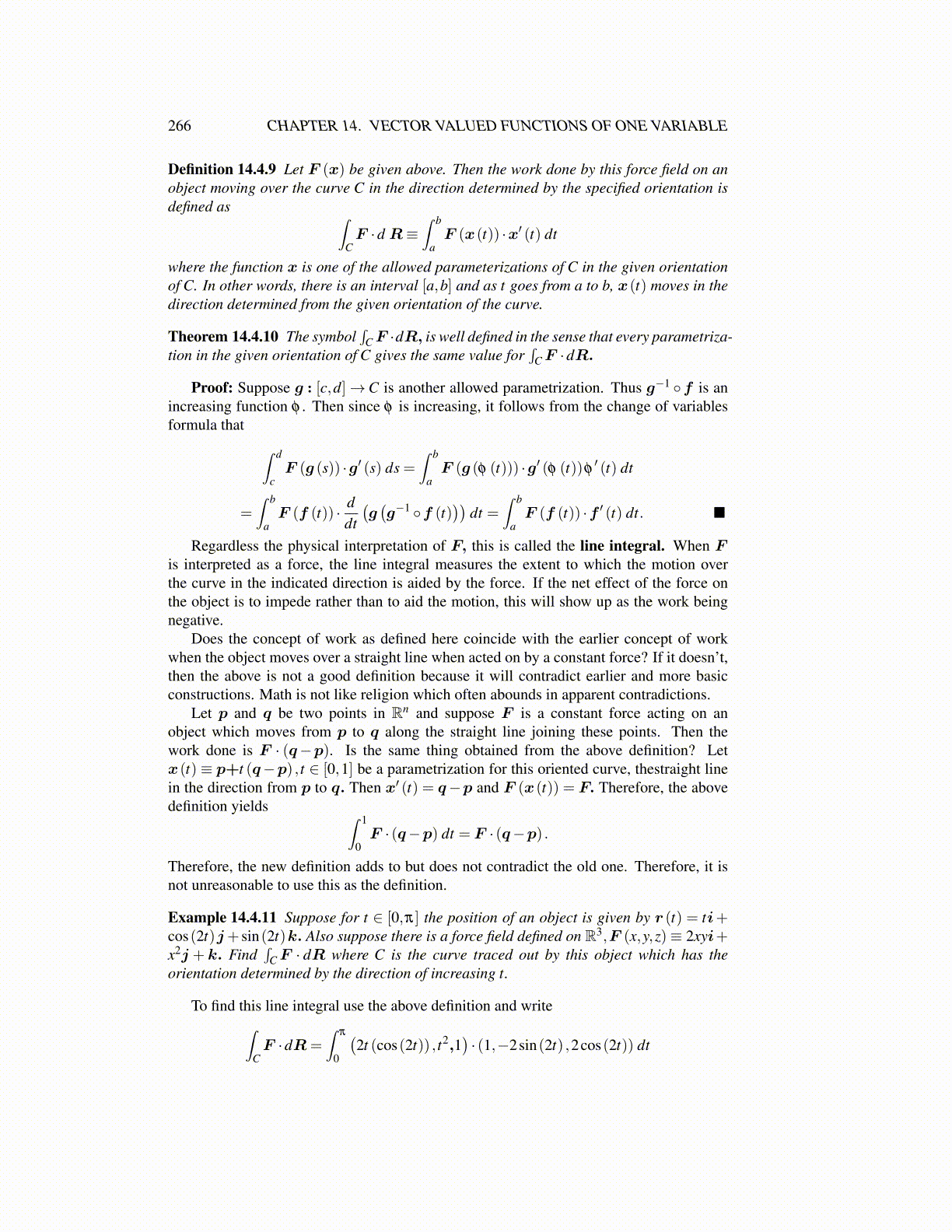
266 CHAPTER 14. VECTOR VALUED FUNCTIONS OF ONE VARIABLE
Definition 14.4.9 Let F (x) be given above. Then the work done by this force field on anobject moving over the curve C in the direction determined by the specified orientation isdefined as ∫
CF ·d R≡
∫ b
aF (x(t)) ·x′ (t) dt
where the function x is one of the allowed parameterizations of C in the given orientationof C. In other words, there is an interval [a,b] and as t goes from a to b, x(t) moves in thedirection determined from the given orientation of the curve.
Theorem 14.4.10 The symbol∫
C F ·dR, is well defined in the sense that every parametriza-tion in the given orientation of C gives the same value for
∫C F ·dR.
Proof: Suppose g : [c,d]→C is another allowed parametrization. Thus g−1 ◦f is anincreasing function φ . Then since φ is increasing, it follows from the change of variablesformula that ∫ d
cF (g (s)) ·g′ (s) ds =
∫ b
aF (g (φ (t))) ·g′ (φ (t))φ
′ (t) dt
=∫ b
aF (f (t)) · d
dt
(g(g−1 ◦f (t)
))dt =
∫ b
aF (f (t)) ·f ′ (t) dt. ■
Regardless the physical interpretation of F, this is called the line integral. When Fis interpreted as a force, the line integral measures the extent to which the motion overthe curve in the indicated direction is aided by the force. If the net effect of the force onthe object is to impede rather than to aid the motion, this will show up as the work beingnegative.
Does the concept of work as defined here coincide with the earlier concept of workwhen the object moves over a straight line when acted on by a constant force? If it doesn’t,then the above is not a good definition because it will contradict earlier and more basicconstructions. Math is not like religion which often abounds in apparent contradictions.
Let p and q be two points in Rn and suppose F is a constant force acting on anobject which moves from p to q along the straight line joining these points. Then thework done is F · (q−p). Is the same thing obtained from the above definition? Letx(t) ≡ p+t (q−p) , t ∈ [0,1] be a parametrization for this oriented curve, thestraight linein the direction from p to q. Then x′ (t) = q−p and F (x(t)) = F. Therefore, the abovedefinition yields ∫ 1
0F · (q−p) dt = F · (q−p) .
Therefore, the new definition adds to but does not contradict the old one. Therefore, it isnot unreasonable to use this as the definition.
Example 14.4.11 Suppose for t ∈ [0,π] the position of an object is given by r (t) = ti+cos(2t)j+ sin(2t)k. Also suppose there is a force field defined on R3,F (x,y,z)≡ 2xyi+x2j + k. Find
∫C F · dR where C is the curve traced out by this object which has the
orientation determined by the direction of increasing t.
To find this line integral use the above definition and write∫CF ·dR=
∫π
0
(2t (cos(2t)) , t2,1
)· (1,−2sin(2t) ,2cos(2t)) dt